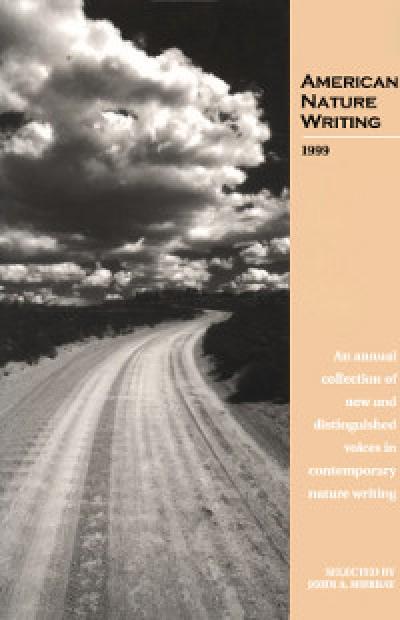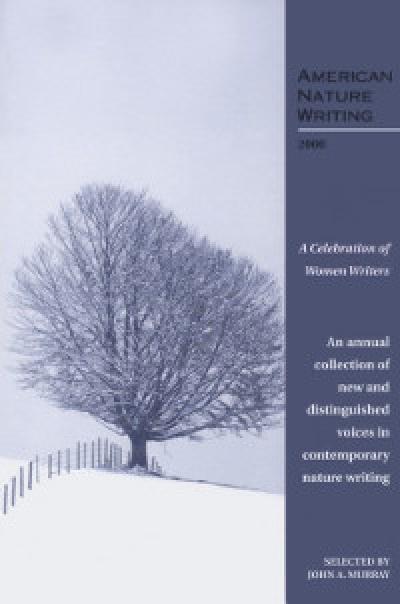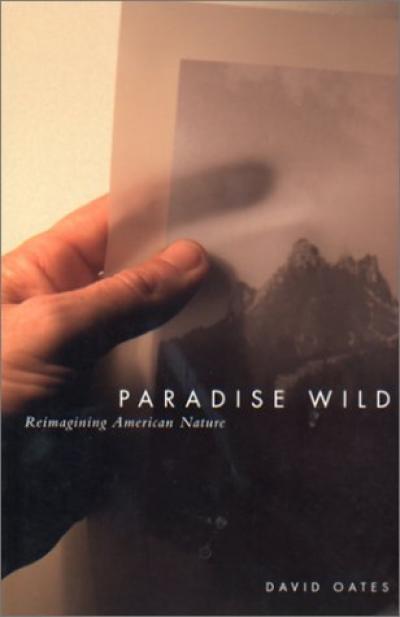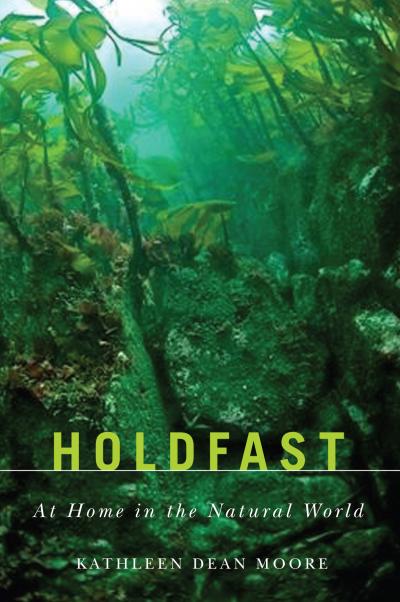American Nature Writing 2001
John A. Murray
The 8th edition of this acclaimed series offers a showcase for contemporary nature writing at the start of the new millennium. With subjects as diverse as the far-flung locations they describe, the 20 writers featured here share one defining objective: to show us that we need only look outdoors to find something worthy of our attention.
In these pages, readers encounter a profusion of natural settings:
- Larry Glass considers the contrast between urban and rural life from his Allegheny Mountain retreat
- Carol Kosarek records a violent encounter between her dog and an injured calf in the hill country of Texas
- Louise Wagenknecht examines the impact that the Pacific Northwest logging industry had on her childhood
- Gretchen Yost recounts her experience fighting fires in Wyoming's Wind River Range
- David Petersen reflects on elk hunting in Colorado
- Bill Sherwonit contemplates the flora and fauna near his suburban Anchorage home
Whether their explorations take them to the north shore of Lake Michigan or to the far reaches of southern Uganda, these writers, both established and emerging voices, demonstrate the continuing vitality of this literature of place.
About the author
John A. Murray is the founding editor of American Nature Writing and the author of many books, including The Sierra Club Nature Writing Handbook. He lives in Denver, Colorado.
Read more about this author
Preface
Introduction
Philip Heldrich, Out Here in the Out There
Carol Ann Bassett, Mount Mazama: The Realm of Becoming
Bill Sherwonit, Anchorage's Hillside; Living with Wildness
Elaine Grings, June Prairie
Larry Glass, Flintstone
Mary Hussmann, Out There
Glenn Vanstrum, Oceans Mexico
Penny Harter, Four Poems
Peter Friederici, May: Clay
Carol Kosarek, A Walk with Misha
David Petersen, The Wapiti's Message
Eva Saulitis, Leaving Resurrection Bay
Thomas Lowe Fleischner, Three Songs from Slickrock
Emma Brown, Climbing Fremont
Joann Verica, Loss of Breath
Melanie Dylan Fox, Nighthiking
Aliette K. Frank, Into the Impenetrable
Susan Zwinger, Mountain Climbing in the North Cascades
Louise Wagenknecht, A Long Death
Gretchen Dawn Yost, First Burn
John A. Murray, From the Faraway Nearby
Notes on Contributors
Permissions
"Nature writing — and there is no escaping the term — may involve people across the earth, and their relationships — but it also includes an assessment of the rock, mud, forest, wild creatures, streams and lakes, and their places in those people's lives and relationships; the stage, so to speak, across which the theater moves."
— Rick Bass, The Literature of Loss (1992)
Since the first Earth Day on April 22, 1970, a once obscure prose genre — nature writing — has steadily grown in stature and popularity, attracting more and more writers and an ever-larger portion of the reading public. At the current time, 2001, it is one of the major prose genres in American literature. Every respectable regional publisher, university press, and major publishing house has a number of accomplished nature writers on its list. Whereas younger writers were once attracted primarily to fiction and poetry, they now gravitate increasingly to nonfiction, and specifically to environmental literature. A number of anthologies are published each year as editors strive to keep up with the numerous fine essays appearing in popular periodicals and new nature books. As a result, nature writing is no longer the home-grown, albeit burgeoning, cottage industry of the 1960s and 1970s, but has become a thriving segment of the American book publishing industry. Many of the best American prose writers are now practicing, either partially or exclusively, in the genre: Barry Lopez, Peter Matthiessen, E.O. Wilson, Richard Nelson, John Haines, Terry Tempest Williams, Linda Hogan, Dan O'Brien, and William Kittredge, to name just a few.
There are several reasons for this literary "Green Revolution." First, the continued urbanization and mechanization of American life, and of the American landscape, has sustained a deep concern for the environment that manifests itself in a growing demand for nature books. Second, during the 1980s and 1990s, Environmentalism, once a fringe populist movement, became politically institutionalized as conservative leaders in the United States, Western Europe, Asia, and Russia suddenly found it expedient to identify themselves as environmentalists and to fight for the new conservationist agenda of their constituencies. Third, since the 1970s, the traditionally preeminent genres of poetry and serious fiction have been in a state of decline. While it was common as recently as the 1950s for poets such as Robert Frost and Dylan Thomas to fill large public venues for their readings, poetry readings today are often poorly attended, and poetry books are rarely printed in runs over 2000 copies because the spurned popular audience has naturally vanished. Additionally, people find much fine poetry in popular song lyrics (from Bob Dylan to Bruce Springsteen, Willie Nelson to Kris Kristofferson, Alanis Morisetta to Fiona Apple). Similarly, serious fiction, which has been criticized severely, (see Tom Wolfe's celebrated 1989 essay in Harper's) for being antinarrative and overly experimental, has also suffered a decline. It is not surprising that audiences have quietly but significantly turned to other genres and art forms for "entertainment and edification" — the Roman poet Horace's description of the purpose art.
The nature-writing phenomenon currently shows no signs of losing momentum, and it is entirely possible that the genre will continue to enjoy something like its current popularity well into the next century. It is also possible that nature writing will eventually cross-fertilize both poetry and fiction, revivifying genres that have grown dangerously estranged from popular audiences. If this does happen, it won't be for the first time. The nonfiction travel and nature writing of the eighteenth century helped to reinvigorate English poetry during the early Romantic periods. Wordsworth, for example, wrote his well-known lyric poem "The Solitary Reaper" after reading a descriptive passage in Thomas Wilkinson's popular travel book A Tour of Scotland. His friend Coleridge composed his lyric poem "Kubla Khan" after reading a descriptive passage in William Bartram's nature book Travels through North and South Carolina, Georgia and East and West Florida. More recently, modern novelists such as Ernest Hemingway (Green Hills of Africa), John Steinbeck (Sea of Cortez), Edward Abbey (The Brave Cowboy, The Monkey Wrench Gang, Fool's Progress) Linda Hogan (Solar Storms, Mean Spirit) and John Fowles (The Tree) have all dabbled in nature writing, as if sensing there was something in the form that could have a positive influence on their imaginative writing. Some of our best contemporary poets and fiction writers are doing the same.
The great American nature book has not been written yet, but may be soon by one of the many fine writers practicing in the genre. The great American nature book is not Henry David Thoreau's Walden, which is a seriously flawed book (a heretical statement but one that finally needs to be made); or Mary Austin's Land of Little Rain, which is subverted by sentimentality from beginning to end; or Also Leopold's A Sand Conty Almanac, which is more a series of sketches than a book. The great American nature book will be written by someone who can be inspired by the canon and yet not be intimidated by it. That we live in what posterity may one day call "The Great Age of Nature Writing" gives one hope that this wonderful work, which will be as much a part of world literature as of American literature, may appear in the next decade or two. History may also record how this iconic book, and the hundreds of other fine nature essays and books surrounding it, brought strong new life back into some of the most important genres in American and English literature.
Whatever we are doing as writers — whether it is Emma Brown writing in these pages of climbing Fremont Peak in Wyoming or Elaine Grings exploring the June prairie in Montana — it is bound up in something larger, part of a mode of thought just being born, a way of being born that will some day, after many ages, prevail. Each of the writers in this book is a part of that movement, a slow transformation which began thirty thousand springs ago in the caves of Lascaux, and that will end in some distant future in which human, and natural, freedom is more perfectly realized. Every person needs something larger than life to devote his or her years to — something to love. What the writers in this book are trying to tell us is that we only have to look outside to find something worthy of our devotion and love.





